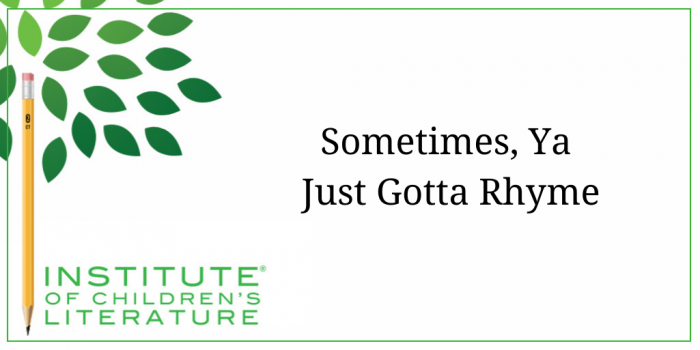1000 N. West Street #1200, Wilmington, DE 19801
© 2024 Direct Learning Systems, Inc. All rights reserved.

I don’t do much rhyming work. I’ve written some poetry for magazines and poetry for testing services, but the bulk of what I write is prose. I enjoy adding a little surprise rhyming to prose for young people, especially in work for early readers. It makes the reading more fun. But I’m not fluent in rhyme.

Because I feel your pain.
For many of us, we’ve read so many rhyming picture books aloud to our kids that we’ve hardwired our brains to think all material for really young kids should rhyme. There are a lot of rhyming picture books published every year. And young children do enjoy rhyme. There’s no doubt about that. But you also constantly hear the advice to write in prose, not rhyme. Why? Doesn’t that seem nonsensical?
Possibly not. You see, there’s this interesting phenomena that goes on in our brains. It’s like this:
Most of us simply cannot tell when our rhyming work is terrible.
You see the skills needed to actually write good rhymes also imparts the ability to judge good rhyme. So if we can’t write it, we also usually cannot tell that we can’t write it. And that’s the trap that catches many, many unpublished picture book authors.
How exactly does that work? Well, to sell a rhyming picture book, certain things have to happen and all three are essential:
The first word that comes to mind when writing a rhyming couplet is probably going to force you into a clichéd, overused line. There’s a reason why our brains deliver that word first: because it’s the over-used word. But many new writers will go with it and then twist the logic of the picture book into knots to accommodate it. Thus many publishers (and agents) get the same bad rhymes over and over and over in the picture books they receive.
If you have no idea what meter is, you should probably go ahead and write prose picture books. Prose picture books are lovely. But for information sake, meter is the number and pattern of stressed and unstressed syllables in a line of your book.

Now, sometimes a skilled writer will vary the meter in a LINE of the picture book when it works with the content or emotion of the story. This can add emphasis. But such variation should never be because you either didn’t know how to write metrical language or you just gave up on getting the line’s meter even.
Having said that, I’m horrible at meter. That’s why I flatly do not write rhyming picture books. I cannot maintain an even meter that long. But when I want to do a short rhyming verse for inside a story or for a standalone poem, I often use a mentor text to set the meter in my head, then write my poem to match it. (This works a bit like a “sung to the tune of” where you write new words for a recognizable melody). I simply read my mentor poem aloud over and over and over and over, and then immediately begin writing mine. I find this makes it considerably easier for me to maintain a set rhythm. I still mark up all the stressed/unstressed syllables as part of my revision process, but I’m more likely to get it right if I have set a meter in my head and written to it.
Metrical patterns aren’t unique so my using an old poem to help set my meter isn’t some form of “naughty” copying. In actuality, there will be hundreds of thousands of poems with that same meter out there. I’m just using that text to help set the meter in my head because I find it easier that way.
The number one most common problem with rhyming picture books is too much attention to rhyming and not enough attention to story. In writing a rhyming picture book you’re trying to do two very hard things at the same time: write flawless rhyme and meter and create a unique compelling story in less than 1000 words (and probably less than 500).

But if your rhyming picture book doesn’t hold together as a story, it doesn’t really matter if you managed to rhyme nicely. The publisher will invest many thousands of dollars in the production and illustration of this book, so they are going to require you do all of the really hard things.
Every successful rhyming picture book is like a Maypole dance between rhyme, meter, and story where each part is so intertwined that you cannot imagine the book working any other way. It’s not easy. But they do delight children so it’s hard work that is certainly worth it when you see your book in the hands of a child. Don’t feel bad if you begin juggling rhyme, meter and story and find one piece or another clunks you on the head. Or all three fall scattered to the floor. You’re trying something hard. Failure is just part of the road to success.
With over 100 books in publication, Jan Fields writes both chapter books for children and mystery novels for adults. She’s also known for a variety of experiences teaching writing, from one session SCBWI events to lengthier Highlights Foundation workshops to these blog posts for the Institute of Children’s Literature. As a former ICL instructor, Jan enjoys equipping writers for success in whatever way she can.
1000 N. West Street #1200, Wilmington, DE 19801
© 2024 Direct Learning Systems, Inc. All rights reserved.
1000 N. West Street #1200, Wilmington, DE 19801
© 2024 Direct Learning Systems, Inc. All rights reserved.
1000 N. West Street #1200, Wilmington, DE 19801
© 2024 Direct Learning Systems, Inc. All rights reserved.
1000 N. West Street #1200, Wilmington, DE 19801
© 2025 Direct Learning Systems, Inc. All rights reserved.
1000 N. West Street #1200, Wilmington, DE 19801
©2025 Direct Learning Systems, Inc. All rights reserved. Privacy Policy.
1 Comment